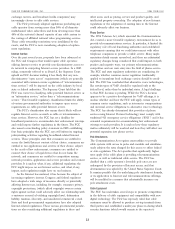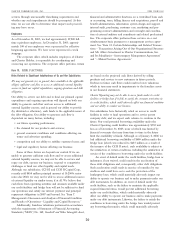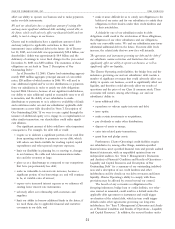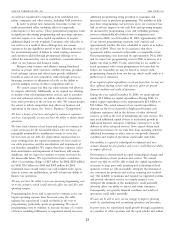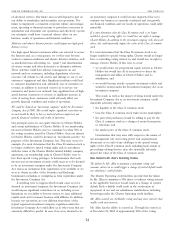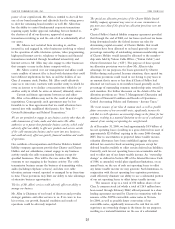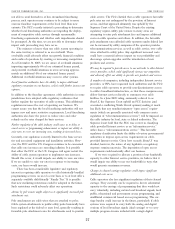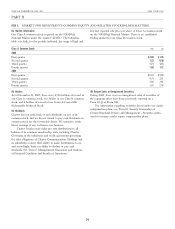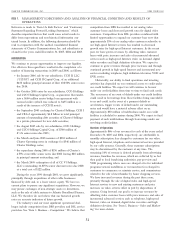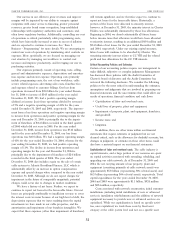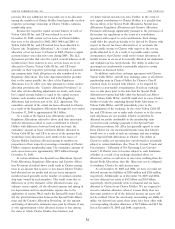Charter 2005 Annual Report Download - page 37
Download and view the complete annual report
Please find page 37 of the 2005 Charter annual report below. You can navigate through the pages in the report by either clicking on the pages listed below, or by using the keyword search tool below to find specific information within the annual report.
CHARTER COMMUNICATIONS, INC. 2005 FORM 10-K
not able to avail themselves of this streamlined franchising cable service. The FCC clarified that a cable operator’s favorable
process, such operators may continue to be subject to more pole rates are not endangered by the provision of Internet
onerous franchise requirements at the local level than new access, and that approach ultimately was upheld by the
entrants. The FCC recently initiated a proceeding to determine Supreme Court of the United States. Despite the existing
whether local franchising authorities are impeding the deploy- regulatory regime, utility pole owners in many areas are
ment of competitive cable services through unreasonable attempting to raise pole attachment fees and impose additional
franchising requirements and whether such impediments should costs on cable operators and others. In addition, the favorable
be preempted. At this time, we are not able to determine what pole attachment rates afforded cable operators under federal law
impact such proceeding may have on us. can be increased by utility companies if the operator provides
The existence of more than one cable system operating in telecommunications services, as well as cable service, over cable
the same territory is referred to as an overbuild. These wires attached to utility poles. Any significant increased costs
overbuilds could adversely affect our growth, financial condition could have a material adverse impact on our profitability and
and results of operations by creating or increasing competition. discourage system upgrades and the introduction of new
As of December 31, 2005, we are aware of overbuild situations products and services.
impacting approximately 6% of our estimated homes passed, We may be required to provide access to our networks to other Internet
and potential overbuild situations in areas servicing approxi- service providers, which could significantly increase our competition
mately an additional 4% of our estimated homes passed. and adversely affect our ability to provide new products and services.
Additional overbuild situations may occur in other systems.
A number of companies, including independent Internet service
Local franchise authorities have the ability to impose additional providers, or ISPs, have requested local authorities and the FCC
regulatory constraints on our business, which could further increase our to require cable operators to provide non-discriminatory access
expenses. to cable’s broadband infrastructure, so that these companies may
In addition to the franchise agreement, cable authorities in some deliver Internet services directly to customers over cable
jurisdictions have adopted cable regulatory ordinances that facilities. In a June 2005 ruling, commonly referred to as
further regulate the operation of cable systems. This additional Brand X, the Supreme Court upheld an FCC decision (and
regulation increases the cost of operating our business. We overruled a conflicting Ninth Circuit opinion) making it much
cannot assure you that the local franchising authorities will not less likely that any nondiscriminatory ‘‘open access’’ require-
impose new and more restrictive requirements. Local franchising ments (which are generally associated with common carrier
authorities also have the power to reduce rates and order regulation of ‘‘telecommunications services’’) will be imposed on
refunds on the rates charged for basic services. the cable industry by local, state or federal authorities. The
Supreme Court held that the FCC was correct in classifying
Further regulation of the cable industry could cause us to delay or cable provided Internet service as an ‘‘information service,’’
cancel service or programming enhancements or impair our ability to rather than a ‘‘telecommunications service.’’ This favorable
raise rates to cover our increasing costs, resulting in increased losses. regulatory classification limits the ability of various governmental
Currently, rate regulation is strictly limited to the basic service authorities to impose open access requirements on cable-
tier and associated equipment and installation activities. How- provided Internet service. Given how recently Brand X was
ever, the FCC and the U.S. Congress continue to be concerned decided, however, the nature of any legislative or regulatory
that cable rate increases are exceeding inflation. It is possible response remains uncertain. The imposition of open access
that either the FCC or the U.S. Congress will again restrict the requirements could materially affect our business.
ability of cable system operators to implement rate increases. If we were required to allocate a portion of our bandwidth
Should this occur, it would impede our ability to raise our rates. capacity to other Internet service providers, we believe that it
If we are unable to raise our rates in response to increasing would impair our ability to use our bandwidth in ways that
costs, our losses would increase. would generate maximum revenues.
There has been considerable legislative and regulatory Changes in channel carriage regulations could impose significant
interest in requiring cable operators to offer historically bundled additional costs on us.
programming services on an ´a la carte basis or to at least offer a
separately available child-friendly ‘‘Family Tier.’’ It is possible Cable operators also face significant regulation of their channel
that new marketing restrictions could be adopted in the future. carriage. They currently can be required to devote substantial
Such restrictions could adversely affect our operations. capacity to the carriage of programming that they would not
carry voluntarily, including certain local broadcast signals, local
Actions by pole owners might subject us to significantly increased pole public, educational and government access programming, and
attachment costs. unaffiliated commercial leased access programming. This car-
Pole attachments are cable wires that are attached to poles. riage burden could increase in the future, particularly if cable
Cable system attachments to public utility poles historically have systems were required to carry both the analog and digital
been regulated at the federal or state level, generally resulting in versions of local broadcast signals (dual carriage) or to carry
favorable pole attachment rates for attachments used to provide multiple program streams included with a single digital
27



